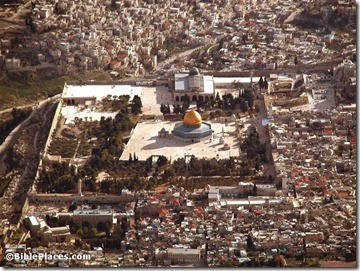Where was the royal palace in Jerusalem during the time of the monarchy? Most scholars have assumed that it was located to the south of Solomon’s temple, between the ancient city and the summit of Mount Moriah. In a 2009 article, David Ussishkin suggests that the palace was built to the north of the temple for the following reasons:
1. It is more logical that the king would desire to isolate his royal compound from the population so that everyone traveling from the city to the temple would not pass by it.
2. In a number of ancient cities, the palace was built at the edge of the acropolis. This was true at the Hittite capital of Hattusha, the Late Bronze cities of Ugarit and Megiddo, as well as a nymber of Assyrian cities including Calah, Nineveh, and Dur-Sharrukin.
Ussishkin notes some difficulties with his hypothesis:
1. Some biblical texts indicate that the palace was south of the temple (Neh 3:25-29; 12:37).
2. The royal acropolis was located in the center of some cities, including Samaria and Zincirli-Sam’al.
I would also question the premise that Solomon would desire to be isolated from the people. God’s intention for Israel’s king was that he would represent the nation to God and vice versa (Deut 17:14-20; 1 Kgs 3:7-10; Ps 72:1-4). The first story of Solomon’s kingship is his adjudication of the case of the dead infant (1 Kgs 3:16-29). The isolation that may have been desired by other kings of the world may not have been appropriate for the king in Jerusalem.
Absent archaeological investigation of the Temple Mount in Jerusalem, it is impossible to confirm the location of the home of Judah’s kings.
Ussishkin’s proposal is a small portion of his article “The Temple Mount in Jerusalem during the First Temple Period: An Archaeologist’s View,” found on pages 473-83 of Exploring the Longue Durée: Essays in Honor of Lawrence E. Stager, ed. J. David Schloen. This thick book is loaded with many articles of interest to students of biblical archaeology.

One thought on “The Location of the Royal Palace in Jerusalem”
Scripture tells us that the house of the king was "…by the conduit of the upper pool, which is in the highway of the fuller's field" (II Kings 18:17). Verse 18 states that they called out to the king from that spot and "there came out to them Eliakim the son of Hilkiah, which was over the household…".
The "conduit" referred to here must be the channel that runs to the south from the Gihon spring because the same meeting place is used by Ahaz as described in Isaiah 7:3 (before Hezekiah constructed his tunnel).